Archivo de noticias y eventos
1401 - 1450 de un total de 2404
También puede acceder a la lista de noticias publicadas en los medios relacionadas con el Instituto de Astrofísica de Andalucía - CSIC.
Pages

|
12/09/2012
La ciencia inunda las calles de Granada El Instituto de Astrofísica de Andalucía (IAA-CSIC) coordina una serie de actividades en defensa de la inversión en ciencia. Se han organizado concentraciones, un flash mob y actividades de divulgación en la calle que buscan concienciar a la población de la importancia de la investigación |

|
20/07/2012
EL PERSONAL DEL INSTITUTO DE ASTROFÍSICA DE ANDALUCÍA (IAA-CSIC) SE CONCENTRA CONTRA LA PRECARIA SITUACIÓN DE LA CIENCIA EN ESPAÑA El personal del Instituto de Astrofísica de Andalucía (IAA-CSIC) quiere manifestar su malestar y preocupación por la situación que atraviesan los centros de investigación del CSIC debido a las sucesivas restricciones presupuestarias |

|
19/07/2012 - 14:00
A deeper look on thick discs using data from the Spitzer Survey of Stellar Structure in Galaxies (S4G) Thick discs are disc-like components with a scale height larger than that of the classical discs. They are most easily detected in close to edge-on galaxies in which they appear as a roughly exponential excess of light which appears a few thin disc scale heights above the midplane. Their origin has been considered mysterious until recently and several formation theories have been proposed. Unveiling the origin of thick discs is... Sébastien Comerón |
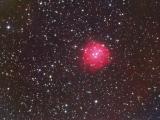
|
16/07/2012
Descubierta la estrella masiva con el campo magnético más intenso conocido El campo magnético de NGC 1624-2, veinte mil veces más intenso que el del Sol, está decelerando su ritmo de rotación |

|
13/07/2012 - 14:00
Jets de Estrellas Jóvenes: Teoría En los últimos años ha habido un gran esfuerzo en la construcción de modelos teóricos que nos permitan entender y explicar distintos aspectos de los jets producidos por estrellas en su vida temprana. Algunos de estos aspectos son: su mecanismo de producción y colimación, la generación de nudos en su interior y la interacción con el medio circundante. En este trabajo se... Jorge Cantó |

|
05/07/2012 - 14:00
Infraestructuras de cálculo en el Instituto de Astrofísica de Andalucía (IAA): pasado, presente y futuro. Actualmente el IAA dispone de una gran infraestructura de cálculo, la conocida Sala Grid, que alberga 32 nodos IBM x3950M2 con un total de 128 procesadores Intel Xeon Quad Core 2.93GHz (512 cores), 4 TeraBytes de memoria RAM, y una capacidad de almacenamiento total de 315 TeraBytes, todo ello interconectado con tecnología de red Infiniband a 20Gbps. Hasta ahora esta infraestructura se ha utilizado dentro del marco del... José Ramón Rodón |
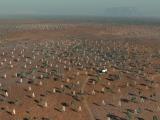
|
28/06/2012
Una mirada verde al cielo La astronomía y las empresas y centro tecnológicos españoles confluyen en el proyecto internacional SKA, una red de sensores radioastronómicos a escala continental |

|
21/06/2012 - 14:00
The AGN-Starburst connection in nearby (U)LIRGs: a radio view I review the main results obtained by our team in the last few years, on studies of nearby Luminous and Ultra-Luminous Infrared Galaxies (LIRGs and ULIRGs, respectively). These galaxies are expected to form stars at rates as large as (10-100) Msolar/yr, or even higher, and constitute excellent laboratories for studies of star-formation. They are also expected to be bright at radio wavelengths. Among other results, I will present... Miguel Ángel Pérez Torres |

|
17/06/2012 - 22/06/2012
TEA-IS Summer School Málaga |

|
14/06/2012 - 14:00
Holographic imaging of dense fields: the amazing poor man's MCAO Being able to image large fields at the diffraction limit of large telescopes is one of Astronomy's oldest dreams. The standard way toward achieving this goal is to throw lots of money at it and build ever more sophisticated adaptive optics (AO) systems. As an alternative way, I present an algorithm for speckle holography that has been optimised for diffraction limited imaging of crowded fields. I will present the exciting... Rainer Schoedel |

|
12/06/2012
Gaia-ESO: la revolución en nuestro conocimiento sobre la Vía Láctea y la evolución estelar Gaia-ESO, uno de los mayores y más ambiciosos estudios realizados desde tierra, analizará unas 100.000 estrellas de la Galaxia. Permitirá un análisis exhaustivo de la formación, evolución y características de las distintas poblaciones de estrellas |

|
04/06/2012
Concluye el estudio sobre el hielo más completo a nivel mundial El IAA ha participado en el estudio más completo realizado hasta la fecha sobre los hielos. El trabajo, en el que han participado 17 científicos de 11 países recoge cuáles son los temas más actuales que existen en este campo de investigación |

|
31/05/2012 - 19:00
Las galaxias guisante: Una versión cercana del Universo primitivo Año 2009. Unos objetos compactos, redondos y verdes. No es de extrañar que los astrónomos aficionados del programa GalaxyZoo , que cuenta con un banco de imágenes online, los llamaran “guisantes verdes” (green peas, en inglés). Buscando en las placas obtenidas por el cartografiado Sloan Digital Sky Survey (SDSS), encontraron 250 entre más de un millón, algo que ningún astrónomo profesional podría haber hecho del mismo modo en una investigación.... Ricardo Amorín |

|
31/05/2012 - 14:00
NITROGEN-TO-OXYGEN RATIO AS A SOLID TOOL TO ASCERTAIN THE CHEMICAL EVOLUTION OF STAR-FORMING GALAXIES Nitrogen is one of the most abundant metals in the ISM and thus emitting strong emission-lines in the optical spectrum of ionized gaseous nebulae. Its nucleosynthetic origin is quite different to that of oxygen as it is produced both by massive stars and by intermediate- and low-mass stars. Thus, the study of the nitrogen-to -oxygen ratio by means of especially defined strong-line methods offers a powerful tool to inspect with... Enrique Pérez Montero |

|
31/05/2012
El Observatorio de Sierra Nevada abre sus puertas al público Por séptimo año consecutivo, el Instituto de Astrofísica de Andalucía (IAA-CSIC) organiza visitas guiadas al Observatorio de Sierra Nevada y al Instituto de Radioastronomía Milimétrica |

|
26/05/2012 - 15:00
Testeado de Posicionadores de Fibras Ópticas y Desarrollo de Interfaz de Comunicación para Instrumentos de Próxima Generación El Robot comercial de montaje Kawasaki, se baraja como posible brazo posicionador de fibras ópticas para del instrumento OPTIMOS-EVE (E-ELT). La Universidad de Oxford forma parte del consorcio de los espectrógrafos OPTIMOS-EVE y WEAVE (WHT, ambos con elementos retractores de fibras de similar diseño. Como parte de mi proyector fin de máster establecí las bases técnicas para la realización de las... Zaira Modroño Berdiñas Sala de Juntas del Nuevo Edificio (IAA-CSIC) |

|
24/05/2012 - 14:00
Development of a miniaturized real time attitude controller for micro and nanosatellites In last years low cost space missions have become an instrument for many research institutes to test new technologies and perform low-orbit Earth science using commercial components. Cubesat represent the most popular standard for microsatellites, but due to low cost components and reduced size, there are no complete attitude controllers available for the smallest versions. This talk will describe the development of a control system... Gian Paolo Candini |
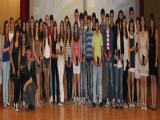
|
18/05/2012
PIIISA 2012 - Jóvenes y ciencia Ayer se clausuró el proyecto PIIISA 2012, un proyecto que pretende acercar a los estudiantes de ESO Y Bachillerato al mundo de la investigación profesional. |

|
17/05/2012 - 14:00
Ice Rocks in the Solar System The study of the minor bodies in the Solar System has historically been a major source of information. The term "Minor Body" covers objects exhibiting very different dynamical and compositional characteristics, in fact, every object in the Solar System that is not a planet or a star, is a minor body. All these objects share a common link, they were the building blocks of the Solar System that we observe today and are considered to... Noemi Pinilla Alonso |

|
10/05/2012 - 14:00
The thirteen billion year history of the most massive black holes Super-massive black holes (BHs) that are found in the centers of most galaxies started their growth when the universe was about 300 million years old. Some of these "seed black holes" were probably the remnants of the earliest stars. The largest BHs, that are some 10^10 times more massive than the sun, accumulated most of their mass during the first 3 billion years after the big bang. The less massive ones are still growing today. I... Hagai Netzer |

|
03/05/2012 - 13:00
Detecting substructure in the galactic stellar halo with Gaia We present a Gaia mock catalogue we have created to test various approaches to detect the presence of past mergers in the Galactic halo. We propose an extension of the great circle cell method of Johnston et al. (1996), which is optimized to identify tidal debris along great circles in the sky. We have added the proper motion information that will be supplied by Gaia to add a kinematical restriction to the original method. We test our... Luis A. Aguilar |
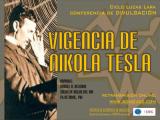
|
26/04/2012 - 19:00
Vigencia de Nikola Tesla ¿Cómo sería el mundo si Nikola Tesla no hubiera existido? Quizá sería como ahora, pero sin duda hubiéramos tardado mucho más en alcanzar el nivel tecnológico actual. Gracias a la mente de este inventor nacido en una pequeña aldea del antiguo imperio austrohúngaro la sociedad avanzó varias décadas. A él le debemos la distribución eléctrica a grandes distancias, la tecnología inalámbrica o la radio, entre otros increíbles inventos. Un visionario... Miguel Ángel Delgado |

|
26/04/2012 - 14:00
The Hubble Space Telescope's Wide Field Camera 3 The Wide Field Camera 3 (WFC3) was installed in 2009 and is now the primary science instrument on HST. Under development since 1998, WFC3 expanded Hubble's ultraviolet and infrared imaging capabilities by factors of more than 20. WFC3 also provides an unparalleled capability for low resolution infrared spectroscopy of very faint sources. This talk will discuss the scientific goals for WFC3, its basic design and technological... John Mackenty |

|
25/04/2012 - 15:00
The Virtual Observatory: The e-Science Environment for Discovery & Collaboration in Astrophysics La astronomía nace cuando el hombre comienza a registrar en diversos medios (tablillas de piedra, papiros, dibujos, fotografías, y recientemente en forma digital) lo que observa en el cielo. En esta charla veremos cómo la cantidad de información accesible a los astrónomos está creciendo de forma exponencial, mientras que su capacidad de procesamiento se está estancando, y que la solución... Juande Santander Vela Sala de Juntas del Nuevo Edificio (IAA-CSIC) |

|
18/04/2012
Más de cien investigadores se reúnen en Granada para debatir sobre el futuro del estudio de las galaxias El congreso, que tendrá lugar desde hoy hasta el viernes, ahondará en una técnica que está resultando revolucionaria en el estudio de la evolución galáctica, la espectroscopía de campo integral |

|
12/04/2012 - 14:00
Oxygen in the Universe: a historic introduction We briefly review the main steps that led to the discovery of oxygen in the Universe and to the understanding of its production and cosmic evolution. We highlight some of the problems that still need an explanation. Grażyna Stasińska |
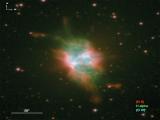
|
11/04/2012
NGC 6778: formación y ruptura de una nebulosa planetaria NGC 6778 muestra unos flujos de material a alta velocidad que han producido la ruptura del "cascarón" de la nebulosa y de su anillo ecuatorial, produciendo así la forma final de esta nebulosa |

|
09/04/2012
El misterioso legado de Nikola Tesla por fin sale a la luz Se han desclasificado unos archivos que muestran una sorprendente faceta del inventor que hizo posible que la electricidad inundara el mundo El Instituto de Astrofísica de Andalucía (IAA-CSIC), uno de los cinco centros elegidos para difundir el material |

|
28/03/2012 - 15:00
Jet wobbling en jets relativistas: el caso del blázar NRAO150 Los jets están presentes en numerosos escenarios astrofísicos. En particular los jets en galaxias con núcleos activos (AGN) son de las fuentes de radiación mas intensas del universo y presentan estructuras observables a longitud de onda de radio que van desde unos pocos parsec a cientos de Kpc. En los últimos años se ha observado en un mayor número de blázares un cambio en la direcci... Sol Natalia Molina Sala de Juntas del Nuevo Edificio (IAA-CSIC) |

|
28/03/2012 - 14:00
A new golden age in Spanish Astronomy: the GTC Spanish Astronomy has experienced a great development during the last 20-30 years, which can be, in part, associated to the available technological resources. Extragalactic astronomy started in Spain due to the agreement for the development of the Observatory of the Roque de los Muchachos, with the installation of the INT 2.5m and WHT 4.2m telescopes and their associated instrumentation. Of course the CAHA... Josefa Masegosa |
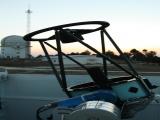
|
19/03/2012
La red española de telescopios robóticos BOOTES inaugura su estación en China El proyecto, liderado por astrónomos del Instituto de Astrofísica de Andalucía, cuenta ya con dos estaciones en España y una en Nueva Zelanda |

|
15/03/2012 - 13:00
What can we learn from gamma-ray anisotropies? Over the last two decades the study of angular anisotropies provided a huge amount of information, when used to analyze the Cosmic Microwave Radiation. The same approach can be extended also to higher energies, studying angular fluctuations in the gamma-ray emission. In this talk I will refer in particular to the data of the Fermi-LAT telescope that has recently presented its measurement of the angular power spectrum (APS) of anisotropies at... Mattia Fornasa |

|
05/03/2012 - 16:00
LINERs, ¿Son también AGNs? Los LINERs (Low Ionization Narrow Emission-line Regions) representan la población más abundante de los AGNs en el Universo local. Se trata de AGNs de baja luminosidad, que podrían resultar ser el nexo de unión entre las galaxias normales y las activas. Haremos un recorrido por las características que muestran los LINERs, tratando de introducirlos en el modelo unificado de AGNs. Lorena Hernández García Sala de Juntas del Instituto de Astrofísica de Andalucía (IAA-CSIC) |

|
05/03/2012 - 13:00
MIRADAS: The Next-Generation Infrared Spectrograph for the GTC MIRADAS is a near-infrared multi-object R=20,000 echelle spectrograph for the 10.4-meter Gran Telescopio Canarias. It is the most powerful astronomical instrument of its kind ever envisioned, with an observing efficiency more than an order of magnitude greater than current capabilities for 10-meter-class telescopes. The (still-growing) MIRADAS science team includes more than 40 scientists from 8 institutions in the GTC community. In this talk... Stephen Eikenberry |

|
23/02/2012 - 13:00
Seeking and Mocking Non-thermal Emission in Galaxy Clusters Diffuse synchrotron radio emission is observed in many clusters of galaxies probing the presence of high energy cosmic ray (CR) electrons. This emission can be explained by the hadronic model where the electron population originates from the interactions between CR protons and the cluster ambient gas. Additionally, a very high energy gamma-ray emission is also expected. I will briefly review the current knowledge on the non-thermal emission... Fabio Zandanel |

|
20/02/2012
HEXA: el futuro del cartografiado del universo Hoy comienza una reunión en la que se presentará a la comunidad astronómica HEXA, un proyecto para un nuevo telescopio de 6,5 metros que se situaría el Observatorio de Calar Alto (Almería). |

|
16/02/2012 - 13:00
Modelos teóricos de las nebulosas de Eta Carinae En esta plática se presentan modelos teóricos de los eventos eruptivos de 1840 (la gran erupción) y de 1890 (la menor erupción) de la estrella masiva Eta Car. Las nebulosas bipolares en torno a la estrella se formaron de la interacción del material eyectado durante estas erupciones con el viento estándar de la estrella. En nuestros modelos, se supone un escenario de colisión de... Ricardo Francisco González Domínguez |

|
14/02/2012
Avances en la protección del cielo de los observatorios andaluces Hoy se publican las zonas de influencia de los observatorios de Sierra Nevada y de Calar Alto, que fijan las condiciones de alumbrado en la zona |

|
09/02/2012 - 16:00
Supernovas. Dónde, cuándo y por qué Las explosiones de supernova se encuentran entre los fenómenos más violentos del Universo y la enorme energía que se libera en ellas hace que podamos observarlas a grandes distancias. Estudiando el lugar y la velocidad a la que se producen, podemos obtener información física fundamental de las galaxias en las que ocurren. En concreto, veremos cómo la distribución radial de supernovas a lo largo... Rubén Herrero Illana Sala de Juntas del Instituto de Astrofísica de Andalucía (IAA-CSIC) |

|
02/02/2012 - 13:00
Efectos de los cúmulos ionizantes de baja masa en el espectro de regiones HII y galaxias En este seminario presentaré mi trabajo de tesis sobre el modelado del espectro de líneas de emisión de regiones H II y galaxias con formación estelar. Primero hablaré sobre la influencia de los efectos de muestreo de la función inicial de masas estelares (IMF) en el continuo ionizante de los cúmulos y en el espectro de regiones H II, centrando la atención en los cú... Marcos Villaverde |

|
26/01/2012 - 19:00
Mundo amigo, Mundo Cruel Hace cerca de 4.500 millones de años, el planeta Tierra se formó a partir del material que quedaba alrededor del Sol. Fue el comienzo de un largo, violento y caótico periodo en el que se configuraron la corteza terrestre, los océanos, la atmósfera y todos los elementos que conforman el paisaje terrestre que hoy conocemos. Teniendo en cuenta que durante este proceso también se crearon las condiciones óptimas para el desarrollo de la vida, no... Javier Almendros y Miguel Abril |

|
26/01/2012 - 13:00
Maser emission in evolved stars: from AGB to PNe I will present a review of maser emission in evolved stars from the asymptotic giant branch (AGB) to planetary nebulae (PNe). The circumstellar envelopes of oxygen-rich evolved stars provide optimal conditions to pump different species of masers, emitting at radio wavelengths. Interferometric observations of masers are a powerful tool to study with the highest angular resolution the molecular gas around evolved stars, because... Lucero Uscanga Aguilera |

|
19/01/2012 - 13:00
Dwarf galaxies as dark matter laboratories Dwarf spheroidal galaxies are key objects in the current cosmological paradigm: first, they are the least luminous galaxies, likely signaling the minimum halo mass at which gas can be accreted and converted into stars. Second, they all have ancient stellar populations, providing clues on star formation/feedback processes at early stages of the Universe. Third, they are the most numerous satellites about the Milky Way and M31,... Jorge Peñarrubia |

|
17/01/2012 - 13:30
Albedo and atmospheric constraints of dwarf planet Makemake from a stellar occultation Makemake is an icy dwarf planet with a spectrum similar to Eris and Pluto, and is currently at a distance to the Sun intermediate between the two. Although Makemake’s size (1,420 ± 60 km) and albedo are roughly known, there has been no constraint on its density and there were expectations that it could have a Pluto-like atmosphere. Here we report the results from a stellar occultation by Makemake on 2011... José Luis Ortiz |

|
12/01/2012 - 13:00
Everything you always wanted to know about extinction but were afraid to ask Twenty two years ago Cardelli et al. published their seminal paper on Galactic extinction laws. In the first part of my talk I will explore that (often quoted but also often misunderstood) paper and detail its strengths and weaknesses. In the second part I will describe the two datasets that have finally allowed the Cardelli et al. laws to be tested to their limit and I will present a new family of extinction laws derived from the new data... Jesús Maíz Apellániz |

|
11/01/2012 - 16:00
Profundidad de falla y flujo térmico en Mercurio Los escarpes lobulados son las estructuras tectónicas más relevantes existentes en Mercurio. Su morfología y la deformación producida en su intersección con otras estructuras indican que los escarpes constituyen la expresión en superficie de fallas inversas formadas, principalmente, por el enfriamiento y contracción del planeta. A partir de la geometría de estas fallas podemos obtener... Mª Isabel Egea González Sala de Juntas del Instituto de Astrofísica de Andalucía (IAA-CSIC) |

|
10/01/2012 - 13:30
IAA: its structure, failures, and potential In this talk I will first show the structure of our Institute, the task division and the people responsible for these taks. I will also analyse all the procedures, customs and usages that drift us apart from the dream IAA. Finally, I will make some remarks about the (underestimated? disregarded?) potential of our Institute. Matilde Fernández Hernández |

|
22/12/2011 - 12:34
Dynamical Modeling of Luminous Infrared Galaxy Mergers It is widely accepted that galaxy mergers can have a significant effect on galaxy properties and may be an important part of galaxy evolution. Enhanced star formation is one frequently observed property of (gas rich) mergers and theoretical prescriptions for star formation can generally reproduce the observed behavior. However a detailed study comparison of these prescriptions with individual galaxy merger events has not been... George C. Privon |
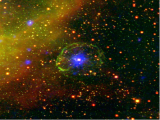
|
18/12/2011
Un púlsar demasiado lento para su edad No solo se trata de uno de los púlsares más lentos conocidos, sino que esa lentitud parece incompatible con su corta edad |
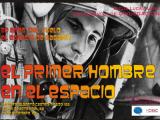
|
15/12/2011 - 19:00
El primer hombre en el espacio Yuri Gagarin fue el primer hombre en orbitar alrededor del planeta tierra. Un auténtico heroe nacional para los rusos tuvo un final envuelto en misterio como el resto de su vida. En esta charla se da un repaso a estos primeros años de la carrera espacial y a los hombres que la hicieron posible. Alberto Castro-Tirado |